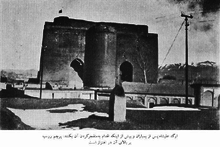1911 Russian invasion of Tabriz
| Russian invasion of Tabriz (1911) | |||||||||
|---|---|---|---|---|---|---|---|---|---|
 First round of execution of revolutionaries and Tabrizi people by Russian forces. The gibbet is colored in the Russian Tsar's flag colors. | |||||||||
| |||||||||
| Belligerents | |||||||||
|
| Constitutionalists | ||||||||
| Commanders and leaders | |||||||||
|
|
Seqat-ol-Eslam Tabrizi | ||||||||
Russian invasion of Tabriz (1911) (Persian: اشغال تبریز بدست قوای روس (۱۲۹۰ خورشیدی)) refers to the attack and invasion of the city of Tabriz in the north western part of Iran in December 1911 by Imperial Russia. The Russian invasion began an occupation which continued into the course of World War I. This occupation was in retaliation for the Iranian Parliament's refusal to accept the Russian ultimatum. The Russian Ultimatum had three major demands for the Iranian government, amongst which the most important was to fire the newly employed American lawyer Morgan Shuster. Shuster had been hired by the Parliament of Iran to organise the country's financial affairs. Upon the Iranian parliament's refusal to fire Shuster, the Iranian government dissolved the parliament and agreed to the Russian ultimatum. Nevertheless, the Russian Imperial Army invaded northwestern Iran. Its aim was to occupy three major cities: Tabriz, Anzali and Rasht. The most fierce battle of the Russian invasion occurred in Tabriz, where the constitutionalists resisted. After about three days, the defense of the city's residents broke. The Russians shelled Tabriz with artillery and entered the city.
The Russians executed the constitutional revolutionaries of Tabriz and their relatives en masse and many civilians of Tabriz as well. The total number of executions is estimated to have been about 1,200. Russians also destroyed part of the Arg of Tabriz by shelling it. Fire broke out in the Arg while it was held by Russian troops.[1]
As a result of the campaign, Tabriz was re-occupied by the Russians.[2] The Russian forces remained in the city until 1917.[2]
 Russian flag over the Arg of Tabriz
Russian flag over the Arg of Tabriz Fire in the Arg set by Russian troops
Fire in the Arg set by Russian troops
See also
References
- ↑ Hasan Javadi; Edward Granville Browne (2008). Letters from Tabriz: The Russian Suppression of the Iranian Constitutional Movement. Mage Publishers. ISBN 978-1-933823-25-6.
- 1 2 Cronin 2013, p. 323.
Sources
- Cronin, Stephanie, ed. (2013). Iranian-Russian Encounters: Empires and Revolutions Since 1800. Routledge. ISBN 978-0415624336.
| Wikimedia Commons has media related to Russian Invasion of Tabriz, 1911. |